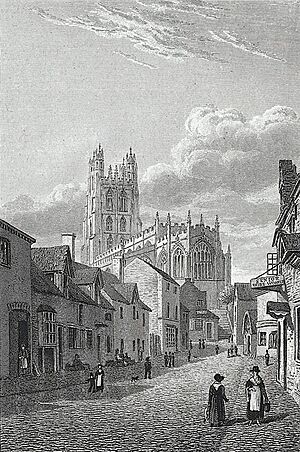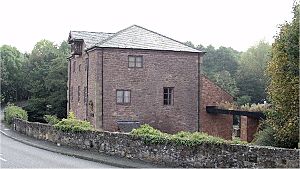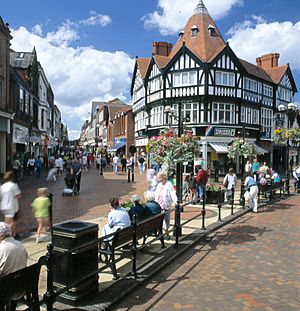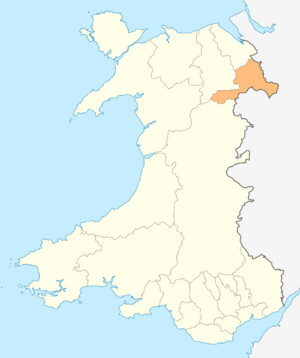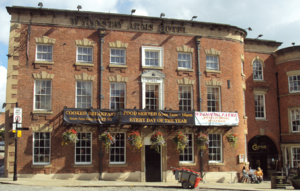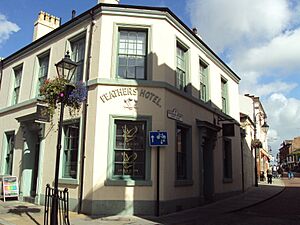History of Wrexham facts for kids
Wrexham is a city in north-east Wales with a very long history. It used to be a busy market town and was a big centre for factories and heavy industry in the 1800s and 1900s. Today, Wrexham is a lively place for shops and businesses. It officially became a city in 2022.
Contents
Wrexham's Earliest Days: From Stone Age to Romans
Around 8,000 years ago, during the Middle Stone Age (called the Mesolithic period), people started exploring the area where Wrexham is now. These early people were hunter-gatherers, meaning they hunted animals and gathered plants for food. They moved around a lot, so they didn't leave many big signs of their lives. We mostly find small flint tools, called microliths, in places like Borras.
Later, in the New Stone Age (Neolithic period, 4300 – 2300 BC), people started farming. We've found stone axe heads from this time in Borras, Darland, and Johnstown.
During the Bronze Age, about 4,000 years ago, two large mounds were built in Wrexham. These are called Fairy Mount and Hillbury. They are likely ancient burial sites. Interesting axe heads found in Acton Park show that people in Wrexham were very skilled at working with metal back then.
Wrexham is surrounded by several rivers like the Clywedog, Alyn, and Gwenfro. These rivers flow into the River Dee. In ancient times, these rivers were like highways, helping people travel and trade. Finds along the River Alyn show that people traded with places as far away as Ireland during the Bronze Age.
In the Iron Age, people built large forts on hills nearby. These hillforts, like Bryn Alyn and Y Gardden, might have marked the borders between different tribes.
When the Roman Empire came to Britain, the Wrexham area was home to a tribe called the Cornovii. Their main town was at Wroxeter, near Shrewsbury. One idea is that the name 'Wrexham' might come from 'Wreocensaetan', meaning 'settlement of people from the Wrekin' (a hill near Wroxeter).
Around 70-75 AD, the Romans built a big army base called Deva (which is now Chester). For the next 300 years, this base was home to the Twentieth Legion, a powerful Roman army group. We've found signs of Roman life nearby in Holt, where they made tiles and pottery. More recently, during building work in Wrexham, traces of Roman farms and coins from around 150-350 AD were discovered.
The Mercian Kingdom and Wrexham's Name
After the Romans left Britain, Wrexham became part of a Welsh kingdom called Powys. This kingdom stretched from the mountains of Wales to what is now central England.
Towards the end of the 500s, English settlers started moving into the area. These people were from a kingdom called Mercia, which means 'border people'. By the 7th century, the border between the Welsh and English was forming.
In the 8th century, the Mercians became very powerful. They built two large earth walls, Wat's Dyke and Offa's Dyke, to mark their border with the Welsh kingdom of Powys. These dykes pass just west of Wrexham, suggesting that Wrexham was inside Mercian land at that time.
It's thought that Wrexham was founded by Mercian settlers in the 8th century. They built the settlement on flat land near the River Gwenfro, which was great for grazing animals. The name 'Wrexham' might come from an Old English name 'Wryhtel' and 'hamm', meaning 'water meadow' or 'enclosure'. So, it could mean 'Wryhtel's meadow'.
Even though the English took control, not many English people moved into the Wrexham area at first. Many field names in the area were still Welsh until the early 1900s.
Welsh Control Returns and Border Fights
In the early 900s, Welsh and Viking attacks weakened English power in North Wales. By 1056, a powerful Welsh leader named Gruffudd ap Llewellyn became King of Wales and likely took control of Wrexham. Because the Welsh were in charge, Wrexham isn't mentioned in the Domesday Book, a big survey of England done in 1086.
Between 1086 and 1277, the Wrexham area was part of a Welsh lordship called Maelor. The lords of Maelor lived at Dinas Bran castle. This area was known as 'Maelor Cymraeg', meaning 'Welsh Maelor'. Under Welsh rule, Welsh laws and customs were followed in Wrexham.
The area was often fought over between the Welsh and the English. In 1161, a castle at 'Wristlesham' (an early name for Wrexham) was mentioned. In 1165, the English King Henry II led his army into Wales but was defeated by the Welsh. However, the English Earl Hugh of Chester conquered Bromfield (the English name for Maelor) in 1177, but this was only temporary. The Welsh Princes of Powys soon took it back.
This period of stability allowed Wrexham to grow as a trading town and an important administrative centre. In 1202, the Lord of Dinas Brân, Madog ap Gruffydd Maelor, gave some of his land in 'Wrechcessham' to a new monastery. The Wrexham Parish Church was first mentioned in 1220.
In 1277, after Madog II ap Gruffydd died, his lands were taken over by the English King Edward I. In 1282, Wales lost its independence when Prince Llywelyn ap Gruffudd was killed. King Edward I then gave the lordships of Bromfield (Maelor) and Yale to John de Warenne. The King himself even stayed briefly in Wrexham in 1294 during a Welsh revolt.
Wrexham in the Later Middle Ages
By 1327, Wrexham was called a villa mercatoria, which means a market town. By 1391, it was rich enough that poets, entertainers, and even a goldsmith could make a living there.
Welsh traditions stayed strong in Wrexham. English people who moved there often adopted Welsh names and customs.
In the early 1400s, local people supported the rebellion led by Owain Glyndŵr. This rebellion caused economic problems for Wrexham. The local poet Glyn Guto'r Glyn even called Sion ap Madog, a relative of Owain Glyndŵr, "an Alexander for Wrexham," meaning a great hero.
In the mid-1400s, the main church in Wrexham was badly damaged by fire. The church we see today was mostly built in the late 1400s and early 1500s.
Wrexham in the 1500s and 1600s
The Acts of Union in the 1500s brought Wales fully into the English system of law and government. Wrexham became part of the new county of Denbighshire in 1536.
Wrexham was still mostly a farming area in the 1600s. But there were also workshops for weavers, people who made nails, and dye houses. A grammar school was opened in 1603.
A survey in 1620 showed that most landowners in Wrexham had Welsh names, and almost all the fields had Welsh or partly Welsh names.
During the English Civil War, Wrexham supported the King, like most Welsh gentry. However, a local landowner, Sir Thomas Myddelton of Chirk Castle, supported Parliament.
Wrexham's Industrial Boom: 1700s and 1800s
In the 1700s, Wrexham was known for its leather industry. People called skinners and tanners worked with animal hides. They also used horns from cattle to make things like combs and buttons. There was also a nail-making industry. But in the mid-1700s, Wrexham was still a small market town with about 2,000 people.
The late 1700s brought a huge change with the industrial revolution. This began when a famous businessman named John Wilkinson, known as 'Iron Mad Wilkinson', opened the Bersham Ironworks in 1762. He later opened a metal smelting plant in Brymbo in 1793.
Wrexham got its first newspaper in 1848, the same year the Market Hall was built. By 1849, Wrexham had a population of nearly 13,000 people.
In 1849, Wrexham was connected to the rest of the UK by railway. This grew into a big network, especially helping the steelworks at Brymbo and the limeworks at Minera.
Wrexham had excellent underground water, which was perfect for making beer. So, brewing became one of its main industries. In the mid-1800s, there were 19 breweries in and around the city! The most famous was the Wrexham Lager brewery, built in 1881-1882. It was the first brewery in the UK to make lager beer.
Wrexham is also near rich clay beds, so several brickworks opened. Coal mining was another very important industry, providing many jobs. Mines like Llay, Gresford, and Bersham were built, and new settlements grew up around them for the miners. Other types of mining, like lead mining in Minera, also took place.
Wrexham in the 1900s and 2000s
In the second half of the 1900s, Wrexham went through a tough time. Many coal mines closed, then the brickworks, and finally the steelworks in the 1980s. Wrexham faced an economic crisis, and many people struggled to find jobs.
To help Wrexham recover, the Welsh Development Agency (WDA) stepped in during the 1980s and 1990s. They funded a major dual carriageway road, the A483, which helped connect Wrexham to other big cities like Chester and Shrewsbury. They also helped clean up areas damaged by coal mining and invested in new shops in the city centre.
The biggest success was the Wrexham Industrial Estate. This area, which was used during the Second World War, became home to many big manufacturing companies like Kellogg's (who make cereal), JCB (who make diggers), Duracell (who make batteries), and Pirelli (who make tyres). It's now one of the largest industrial estates in Europe. Other big companies like Sharp, Brother, Cadbury, and Flexsys also have factories in the Wrexham area. In 2012, the last British typewriter was made at the Brother factory in Wrexham.
Economy Today
In November 2006, the number of people without jobs in Wrexham was 1.9%. This was lower than the average for Wales and the UK, showing a healthy job market.
City Centre Improvements
In recent years, Wrexham's city centre has seen a lot of improvements. Public spaces like Queens Square, Belle Vue Park, and Llwyn Isaf have been redeveloped. New shopping areas have also been created at Henblas Square, Island Green, and Eagles Meadow.
Becoming a City
Wrexham is the largest town in North Wales and had tried to become a city several times before. It applied in 2002 and 2012 but wasn't chosen. However, in 2022, Wrexham tried again for the Queen's Platinum Jubilee. On May 20, 2022, it was announced that Wrexham's bid was successful! It officially became a city on September 1, 2022, and celebrations were held throughout September.
Historic Hotels, Inns, and Pubs
Wrexham has many old and interesting buildings that used to be hotels, inns, or public houses (pubs).
Wynnstay Arms Hotel
The Wynnstay Arms Hotel on Yorke Street was built in the 1700s. Its name comes from Wynnstay, a large country house nearby. The Football Association of Wales, which runs football in Wales, was actually started at a meeting in this hotel on February 2, 1876.
Elephant and Castle
The Elephant and Castle on Charles Street was a public house. We know it existed in 1788, and it closed its doors in 1999.
Feathers Inn
The Feathers Inn on Chester Street was a coaching inn, which means it was a place where horse-drawn coaches would stop for travellers to rest. It was first established in the late 1700s. It closed in the late 1990s and is now used as a shop. The original building was rebuilt around 1850-1860. It is now a listed building, meaning it's protected because of its historical importance.
Turf Hotel
The Turf Hotel on Mold Road (also known as the Turf Tavern) opened in the 1840s. It's famous for being the only pub in the United Kingdom built inside the grounds of a football club!


